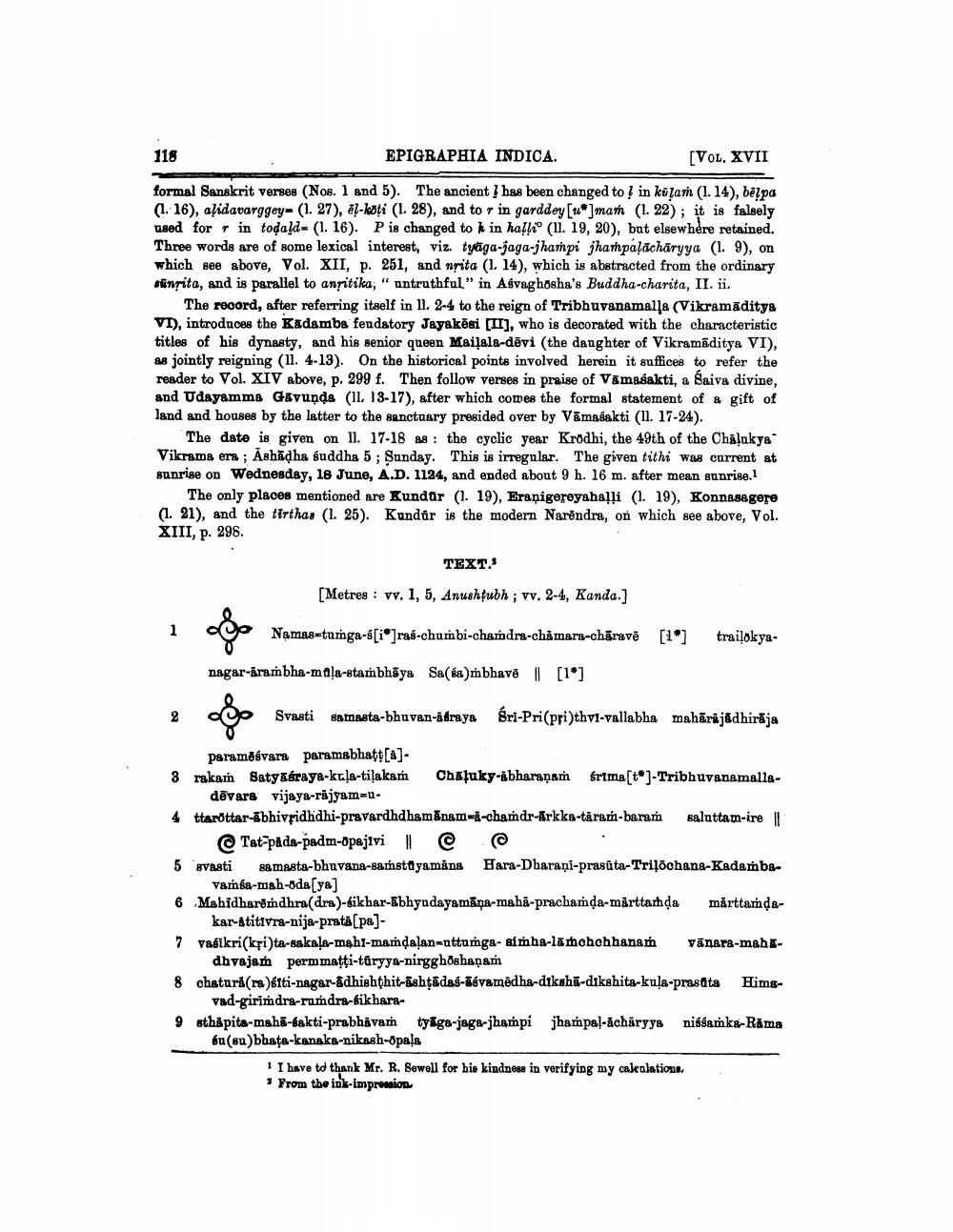________________
118
EPIGRAPHIA INDICA.
[VOL. XVII
formal Sanskrit verses (Nos. 1 and 5). The ancient has been changed to ? in küļam (1. 14), bēļpa (1. 16), alidavarggoy- (1. 27), él-koti (1. 28), and to r in garddey [* ]man (1. 22); it is falsely used for in todald (1. 16). P is changed to k in hallio (11. 19, 20), but elsewhere retained. Three words are of some lexical interest, viz. tyoga-jaga-jhampi jhampalachäryya (1. 9), on which see above, Vol. XII, p. 251, and nrita (1. 14), which is abstracted from the ordinary sünrita, and is parallel to ansitika," untruthful" in Asvaghosha's Buddha-charita, II. ii.
The record, after referring itself in 11. 2-4 to the reign of Tribhuvanamalla (Vikramaditya VI), introduces the Kadamba fendatory Jayakēsi (II), who is decorated with the characteristic titles of his dynasty, and his senior queen Mailala-dēvi (the daughter of Vikramāditya VI), as jointly reigning (11. 4-13). On the historical points involved herein it suffices to refer the reader to Vol. XIV above, p. 299 f. Then follow verses in praise of Vāmasakti, a Saiva divine, and Udayamma Gavunda (11, 13-17), after which comes the formal statement of a gift of land and houses by the latter to the sanctuary presided over by Vāmasakti (11. 17-24).
The date is given on 11. 17-18 as: the cyclic year Krodhi, the 49th of the Chalukya Vikrama era ; Ashādha fuddha 5; Sunday. This is irregular. The given tithi was current at Bunrise on Wednesday, 18 June, A.D. 1124, and ended about 9 h. 16 m. after mean sunrise.
The only places mentioned are Kundar (1. 19), Eraņigereyahaļli (1. 19), Konnagagere (1. 21), and the tirthas (1.25). Kundár is the modern Narendra, on which see above, Vol. XIII, p. 298.
TEXT.
[Metres : vv. 1, 5, Anushțubh ; v. 2-4, Kanda.]
1
Namas-tunga-s[i]ras-chumbi-chamdra-chämara-chāravě
(1")
trailokya
nagar-arambha-ma!a-stambhāya
Sa(ta)mbhavi || [1"]
Svasti samasta-bhuvan-draya
Sri-Pri(pri)thvi-vallabha mahārājadhiraja
paramośvara paramabhatt[a]3 rakam Satyasraya-kula-tiļakam Chaluky-abharaṇam srimasto]-Tribhuvanamalla
dēvara vijaya-rajyam=u. 4 ttaröttar-abhivridhidhi-pravardhdbamānam-a-chamdr-Arkka-tārar-baram saluttam-ire
Tat-pada-padm-Opajivi | © © 5 svasti samasta-bhuvana-samstayamina Hara-Dharani-prasūta-Triļochana-Kadamba
vamsa-mah-oda (ya] 6 Mahidharondhra(dra)-sikhar-ábhyudayamāņa-mahā-prachamda-mårttarhda märttanda
kar-titivra-nija-pratā(pa]7 Valikrikri)ta-sakala-mahi-mandalan=attunga- sinha-lamchchhanam vānara-mahi
dhvajam perm matti-täryya-nirgghoshanam 8 chaturi(ra)fiti-nagar-adhishthit-ishtādas-Távamēdha-dıkshā-dikshita-kula-prastita Hima
vad-girimdra-rumdra-Sikhara9 sthapita-maha-lakti-prabhávam tyaga-jaga-jhampi jhampal-acharyya nissanka-Rama
bu(eu) bbate-kanaka-nikash-Opala
1 I have to thank Mr. R. Sewell for his kindness in verifying my caleulation * From the ink-impronion




